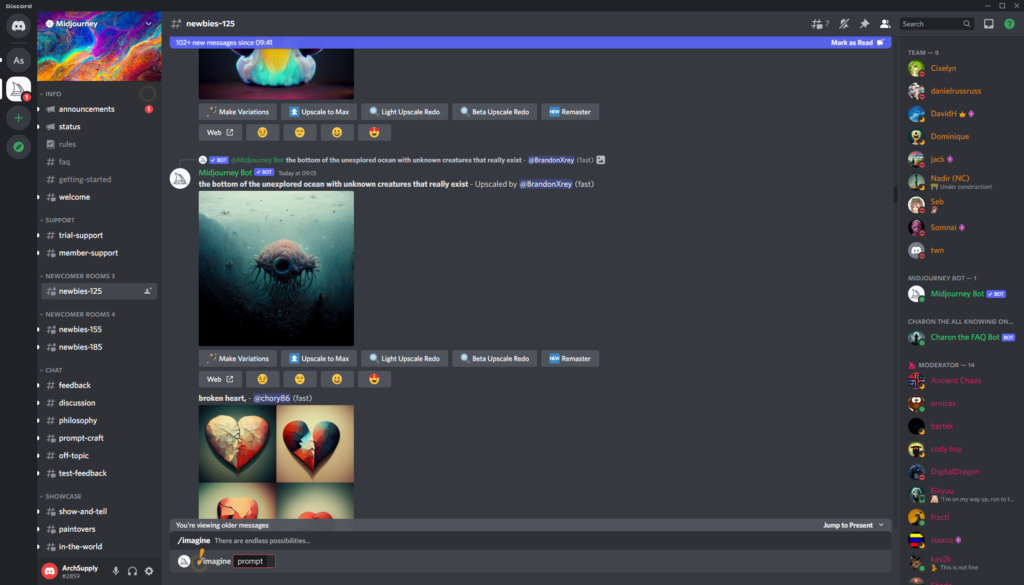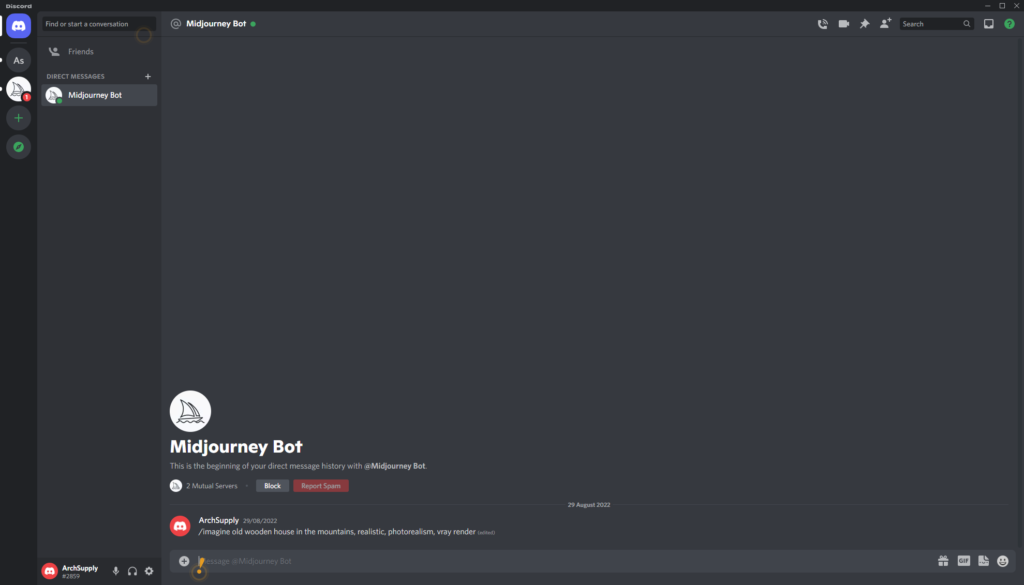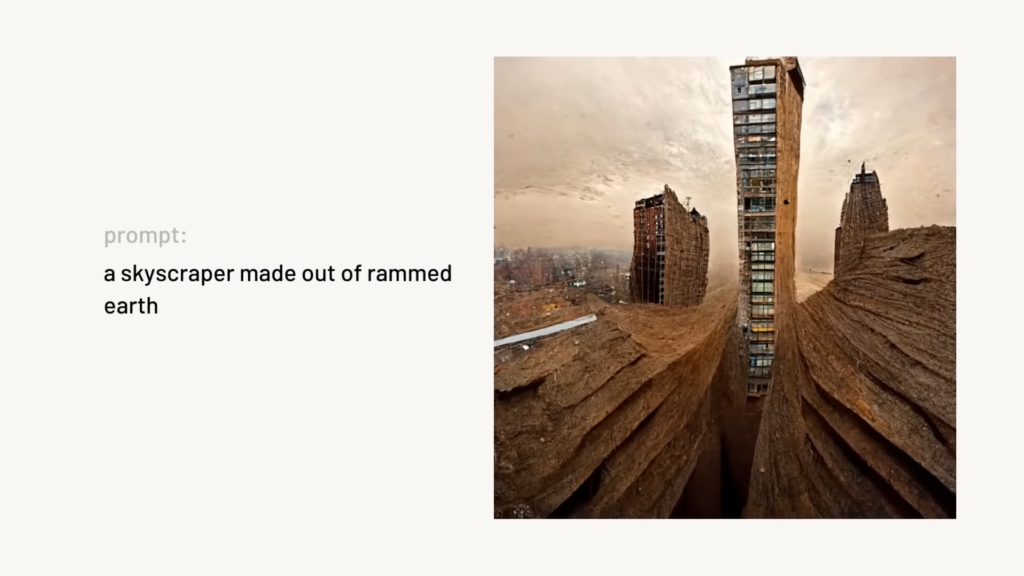- File size:
- 79 MB
- Date added:
- Feb 29, 2024 | Last update check: 1 minute ago
- Licence:
- Trial
- Runs on:
- Web browser on your preferred gadget, tablet, laptop or PC.
Midjourney is a text-to-image (image generation from textual description) AI platform and a co-creation tool for artists and designers. You can write string of text – what Midjourney calls a “prompt” – describing the image that you want to create. These images can range anywhere from art and architecture (architectural concept designs) to graphic design, product design, etc. Midjourney takes a text that you write and pairs that with images from its database. This database is a large collection of images from the web that are tagged with features and parameters. Midjourney includes this information in the construction of the text-based image. Just write text and artificial intelligence makes image for you. It creates any kind of image (photo, 3D rendering, sketch, painting…). The AI is very addictive, it will motivate you to spend hours playing around with the AI, creating variations and upscales, trying different commands, looking at what others are doing, talking about the perfect commands and prompts to use. The AI doesn’t take any of your CPU time.
Midjourney images are mostly based on concept art and 3D rendering style. You will feel like you are in a dream. You can get amazing results easily in seconds, but you never get specifically what you want. You will work with variations. You cannot change these variations with additional commands and instructions what the AI should change about an image. If you want to get your own specific result you still have to do it yourself. The AI cannot create the same specific style for all sorts of images. With a lot of AI renderings you will end up with many different art styles. You can use these images as a backdrop, and put a person or object there, or post-process images in Photoshop or Affinity Photo. You can use Midjourney to create backdrops instead of to search for the right images a long time.
Advantages. Midjourney is known for its artistic style, realism, and customization options. It produces detailed and visually compelling images that lean towards fantasy art. But take into account that the style of Midjourney images can be influenced by the user’s input, so the possibilities are virtually endless. Additionally, you can explore alternatives to find the best fit based on your specific needs and preferences: DALL-E 3, Stable Diffusion XL and SDXL Turbo, Craiyon, Prompt Hunt (with ownership rights), and Microsoft Bing Image Creator. All of these options provide a free version.
How can Midjourney help you in your architectural design? If you are at the beginning of your project, and you have many ideas in mind but not clear visual representation, you can describe concepts you have in mind, and use midjourney to get a set of images that can be inspiration for your designs. Or describe imaginations of your clients, then visualize it and communicate to your client. This workflow can replace reference moodboard that comes with a lot of images. If you already have an architectural design, Midjourney can help you to make it better (for example match keywords from your design with some reference artists outside of architecture).
Subscription plans. Midjourney used to offer a free trial for new users, where they could generate 25 images on a newbie public channel. However, due to overwhelming demand and misuse, the free trial was discontinued. Now, Midjourney offers four subscription tiers (basic, standard, pro, mega), and you can pay month-to-month or for the entire year.
Midjourney is a powerful application that changes the approach to art and design as you know it. Midjourney is the future how artists will work. Of course, the AI will never replace artists but, for sure, it can be a good source of inspiration. Midjourney is still in beta development and it constantly changes and evolves. Midjourney works through Discord server, and it is a place where you generate images. Discord is a social chatting platform available for Windows, Linux, Mac, Android, iOS, and as a web version.
Midjourney is an open SaaS (software as a service), and the generated images are not entirely your property. Anyone can take it to create their own art. Every image is an unique image generated from scratch using dataset of images.
Typical workflow:
- Basic concepts. Get familiar with the following concepts:
- Discord: Third-party communication platform organized into servers (community spaces) where users can create and join specific interest-based channels.
- Servers: Community spaces on Discord where users gather and interact, often organized around specific interests, games, or topics.
- Channels: Subdivisions within Discord servers, providing dedicated spaces for discussions, each with its own topic or purpose.
- Roles: Assignable permissions defining user access and control levels within Discord servers.
- Midjourney Server: Official server for Midjourney on Discord, with a large community of millions of members.
- Midjourney Bot: The bot responsible for image generation and interaction within the Discord platform, can be added to your own Discord server.
- Prompt: A short text description provided by users to generate unique images using the /imagine command in Midjourney.
- Direct Messaging: One-on-one interaction with the Midjourney Bot within Discord, with slash commands in your own chat room.
- GPU time: The processing time on advanced Graphics Processing Units included in Midjourney subscriptions, tracked with the /info command.
- Image grid: The result of the /imagine command, displaying four unique image options for users to choose from in Midjourney.
- Variations (V buttons): Options in Midjourney to create new image grids with similar styles and compositions based on the selected image.
- Image strength: The degree of influence users can apply to modify the strength of variations in the generated images using the Midjourney Bot.
- Pan buttons: Allow users to expand the canvas of an image in specific directions without changing the original content in Midjourney.
- Zoom out: Midjourney feature allowing users to extend the canvas of an image without altering the original content.
- Favorite: Tagging selected images for easy identification on the Midjourney website.
- Discord: Third-party communication platform organized into servers (community spaces) where users can create and join specific interest-based channels.
- Setup account and subscribe: Create and verify a Discord account to access the Midjourney Bot. Subscribe to a plan on Midjourney.com to start generating images. Check the website for pricing and features of each subscription tier.
- Access server and select channel: Join the Midjourney Server on Discord and locate channels in the sidebar. Select specific channels, general-# or newbie-#, for beginners to interact with the Midjourney bot. Instructions vary for other servers.
- Generate and modify images:
- /imagine command. Use the /imagine command to generate images based on a text prompt. Inside of the prompt box you can write whatever you want to create. It isn’t a form with predefined inputs, you can really enter any text you want. For the best results, use specific keywords to describe type of object, feeling, style, references, composition, etc. You can combine different concepts. To get the aspect ratio, you need to first type “–ar”, then type the ratio (for example –ar 16:9). For example you can type the following text description to generate an image: /imagine old wooden house in the mountains, big windows, photorealism, vray render, 8k. You must accept the Terms of Service presented by the Midjourney Bot before image generation. Press Enter, it starts to render, and shortly after you will have your result.
- Image output. As a result, you will get the image grid – four pictures as four variations (this counts as one picture or one suggestion by the AI). Below the generated image you can see four buttons with prefix U and four buttons with prefix V. U stands for “upscale” so you can get high resolution version of each of four generated images. V stands for “variation” so you can have more variations of any of the four images. Also you can find here a refresh button that you can click if you don’t like any of the generated images, to recreate the same prompt and make four completely new variations.
- Modify images. After selecting an image from the generated grid, use additional options such as varying the image strength, zooming out, panning, and favoriting images.
- Save images and further: Save images by right-clicking (on desktop) or long-tapping (on mobile). All images are immediately available on midjourney.com/imagine. Direct Message the Midjourney Bot for one-on-one interactions. Use additional learning resources for effective prompt writing, exploring different artistic mediums, and using the /blend command to upload and blend images.
What’s new in version 6:
- Improved realism and accuracy: The enhanced AI-driven image generation provides a more realistic and accurate depiction.
- Improved prompting: The advanced image prompting and remix capabilities, the prompting system is significantly different from its predecessor. The AI interprets prompts more accurately.
- Improved Upscaler: The improved upscaler enhances the image quality, and provides expanded upscaling options, including “subtle” and “creative” modes.
- Add text to images: Improved the integration of textual content into the generated images.
- Fine-tuning the output: Refine the generated images to your liking through a conversation with Midjourney, much like how ChatGPT lets you refine DALL-E images.
Gallery

Newbies chat room.

Private chat room with the Midjourney Bot.

A prompt and generated image. ©Show It Better

A prompt and generated image. ©Show It Better

A prompt and generated image. ©Show It Better